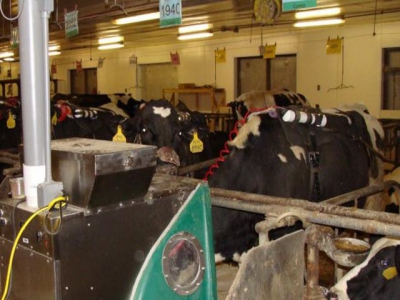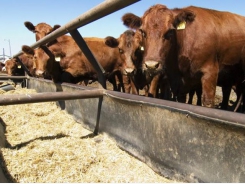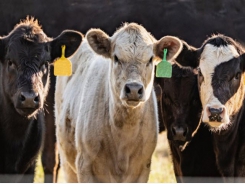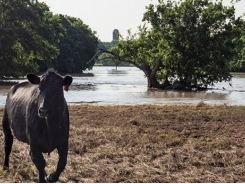Seaweed feed additive may reduce methane emissions

Questions remain regarding long-term effects and availability of adequate quantities of seaweed to feed to dairy cattle.
Cows in the study at the Penn State dairy barns, to eat a sweet treat, put their heads in devices that measure methane they belch. The average dairy cow burps about 380 lb. of methane a year. Early studies show that supplementing their feed with seaweed could mitigate 80% of the potent greenhouse gas. Photo Hristov Research Group/Penn State
Supplementing cattle feed with seaweed could result in a significant reduction in methane belched by livestock, according to researchers at The Pennsylvania State University, but they cautioned that the practice may not be a realistic strategy to battle climate change.
"Asparagopsis taxiformis — a red seaweed that grows in the tropics — in short-term studies in lactating dairy cows decreased methane emission by 80% and had no effect on feed intake or milk yield when fed at up to 0.5% of feed dry matter intake," Penn State distinguished professor of dairy nutrition Alexander Hristov said. "It looks promising, and we are continuing research."
If the seaweed feed supplement is a viable option to make a difference globally, the scale of production would have to be immense, Hristov noted. With nearly 1.5 billion head of cattle in the world, harvesting enough wild seaweed to add to their feed would be impossible. Even to provide it as a supplement to most of the U.S.'s 94 million cattle is unrealistic.
"To be used as a feed additive on a large scale, the seaweed would have to be cultivated in aquaculture operations," he said. "Harvesting wild seaweed is not an option, because soon we would deplete the oceans and cause an ecological problem."
Still, the capability of A. taxiformis to mitigate enteric methane as a feed supplement demands attention, said graduate student Hannah Stefenoni, who is working with Hristov on the research project and will present the research June 23 at the annual meeting of the American Dairy Science Assn. in Cincinnati, Ohio. The findings of their research were published online recently in the Proceedings of the 2019 American Dairy Science Association Meeting.
"We know that it is effective in the short term; we don't know if it's effective in the long term," Hristov explained. "The microbes in cows' rumens can adapt to a lot of things. There is a long history of feed additives that the microbes adapt to, and effectiveness disappears. Whether it is with beef or dairy cows, long-term studies are needed to see if compounds in the seaweed continue to disrupt the microbes' ability to make methane."
There are also questions about the stability over time of the active ingredients — bromoforms — in the seaweed. These compounds are sensitive to heat and sunlight and may lose their methane-mitigating activity with processing and storage, Hristov warned.
Palatability is another question. It appears that cows do not like the taste of seaweed: When Asparagopsis was included at 0.75% of the diet, researchers observed a drop in the animals' feed intake.
Also, the long-term effects of seaweed on animal health and reproduction and its effects on milk and meat quality need to be determined. A panel judging milk taste is part of ongoing research, Hristov said.
Cows burping methane and contributing to climate change has been the subject of considerable derision within the U.S., conceded Hristov, who is recognized as an international leader in conducting research assessing greenhouse gas emissions from animal agriculture. It is taken seriously in other countries, he explained, because the average dairy cow belches 380 lb. of the potent greenhouse gas a year.
Hristov pointed out, however, that "methane from animal agriculture is just 5% of the total greenhouse gases produced in the United States; much, much more comes from the energy and transportation sectors. So, I think it's a fine line with the politics surrounding this subject. Do we want to look at this? I definitely think that we should, and if there is a way that we can reduce emissions without affecting profitability on the farm, we should pursue it."
Also, there may be a hidden benefit, he said.
"It is pretty much a given that if enteric methane emissions are decreased, there likely will be an increase in the efficiency of animal production," Hristov explained.
The seaweed used in the Penn State research was harvested from the Atlantic Ocean in the Azores and shipped frozen from Portugal, the announcement said. It was freeze-dried and ground by the researchers. Freeze drying and grinding four tons of seaweed for the research was "a huge undertaking," Hristov said.
Also involved in the research at Penn State were research technician Molly Young and graduate assistants Audino Melgar Moreno and Susanna Raeisaenen, all in animal science. Camila Lage, a graduate student at Federal University of Minas Gerais, Brazil, also was on the project.
The U.S. Department of Agriculture's National Institute of Food & Agriculture and the Jeremy & Hannelore Grantham Environmental Trust funded this research.
Related news
Tools

Phối trộn thức ăn chăn nuôi

Pha dung dịch thủy canh

Định mức cho tôm ăn

Phối trộn phân bón NPK

Xác định tỷ lệ tôm sống

Chuyển đổi đơn vị phân bón

Xác định công suất sục khí

Chuyển đổi đơn vị tôm

Tính diện tích nhà kính

Tính thể tích ao




 Dairy sensor tech looks to assess milk components
Dairy sensor tech looks to assess milk components  Examine cattle for signs of foot rot
Examine cattle for signs of foot rot